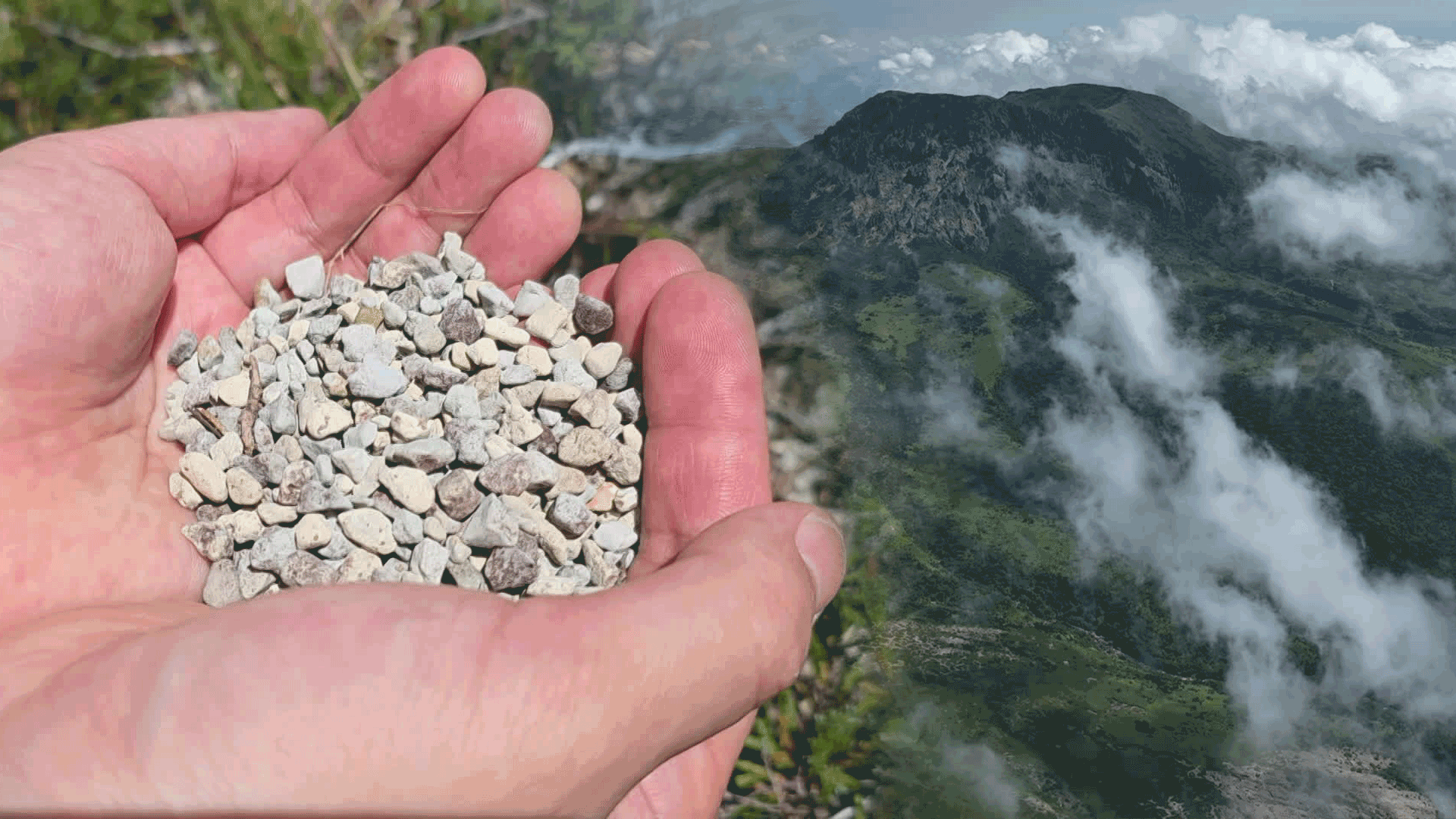[Anchor]
When we think of the 'topography of Jeju Island,' we usually picture black basalt.
However, there is a white pebble beach that resembles a sandy shore on Hallasan, a UNESCO World Heritage site.
This breathtaking view, which has not been accessible to the public until now, was unveiled for the first time today (Aug. 1).
Reporter Min So-young has the story.
[Report]
At an elevation of 1,700 meters on the southwestern side of Hallasan's Baengnokdam, shrouded in clouds,
a grayish-white pebble field stretches between the green pastures.
This 'Mosewat' was formed about 28,000 years ago when a small lava dome collapsed, even before the Baengnokdam crater was created.
Brightly colored rock fragments, eroded by wind and rain, spread across a 2.3 km area with a maximum width of 600 meters.
[Han Yoon-chan/Hallim-eup, Jeju City : "I thought there were only black stones. But I found out that there are white stones here. I'm so glad I came here by chance."]
'Mosewat' is uniquely composed of light-colored rhyolite, unlike the predominantly basaltic composition of Jeju, and was designated as a natural monument on the 15th of last month.
The term 'Mosewat' means 'sandy beach' in the Jeju dialect.
It has been recognized for its academic value in explaining the entire process of the formation of Hallasan's Baengnokdam.
Previously not open to the public, this hidden gem has finally been revealed in celebration of the Year of National Heritage Visits in Jeju this year.
[Ahn Woong-san/Jeju World Heritage Center Researcher: "This rhyolite erupted just before the trachyte at the summit of Hallasan, and afterwards, the trachyte that we see now erupted, creating the current landscape."]
Mosewat will be open twice a day on Wednesdays until the 10th of next month, and due to explosive interest, reservations were fully booked within 30 minutes.
This is KBS News, Min So-young reporting.
When we think of the 'topography of Jeju Island,' we usually picture black basalt.
However, there is a white pebble beach that resembles a sandy shore on Hallasan, a UNESCO World Heritage site.
This breathtaking view, which has not been accessible to the public until now, was unveiled for the first time today (Aug. 1).
Reporter Min So-young has the story.
[Report]
At an elevation of 1,700 meters on the southwestern side of Hallasan's Baengnokdam, shrouded in clouds,
a grayish-white pebble field stretches between the green pastures.
This 'Mosewat' was formed about 28,000 years ago when a small lava dome collapsed, even before the Baengnokdam crater was created.
Brightly colored rock fragments, eroded by wind and rain, spread across a 2.3 km area with a maximum width of 600 meters.
[Han Yoon-chan/Hallim-eup, Jeju City : "I thought there were only black stones. But I found out that there are white stones here. I'm so glad I came here by chance."]
'Mosewat' is uniquely composed of light-colored rhyolite, unlike the predominantly basaltic composition of Jeju, and was designated as a natural monument on the 15th of last month.
The term 'Mosewat' means 'sandy beach' in the Jeju dialect.
It has been recognized for its academic value in explaining the entire process of the formation of Hallasan's Baengnokdam.
Previously not open to the public, this hidden gem has finally been revealed in celebration of the Year of National Heritage Visits in Jeju this year.
[Ahn Woong-san/Jeju World Heritage Center Researcher: "This rhyolite erupted just before the trachyte at the summit of Hallasan, and afterwards, the trachyte that we see now erupted, creating the current landscape."]
Mosewat will be open twice a day on Wednesdays until the 10th of next month, and due to explosive interest, reservations were fully booked within 30 minutes.
This is KBS News, Min So-young reporting.
■ 제보하기
▷ 카카오톡 : 'KBS제보' 검색, 채널 추가
▷ 전화 : 02-781-1234, 4444
▷ 이메일 : kbs1234@kbs.co.kr
▷ 유튜브, 네이버, 카카오에서도 KBS뉴스를 구독해주세요!
- Hallasan’s Mosewat unveiled
-
- 입력 2025-08-02 03:36:30

[Anchor]
When we think of the 'topography of Jeju Island,' we usually picture black basalt.
However, there is a white pebble beach that resembles a sandy shore on Hallasan, a UNESCO World Heritage site.
This breathtaking view, which has not been accessible to the public until now, was unveiled for the first time today (Aug. 1).
Reporter Min So-young has the story.
[Report]
At an elevation of 1,700 meters on the southwestern side of Hallasan's Baengnokdam, shrouded in clouds,
a grayish-white pebble field stretches between the green pastures.
This 'Mosewat' was formed about 28,000 years ago when a small lava dome collapsed, even before the Baengnokdam crater was created.
Brightly colored rock fragments, eroded by wind and rain, spread across a 2.3 km area with a maximum width of 600 meters.
[Han Yoon-chan/Hallim-eup, Jeju City : "I thought there were only black stones. But I found out that there are white stones here. I'm so glad I came here by chance."]
'Mosewat' is uniquely composed of light-colored rhyolite, unlike the predominantly basaltic composition of Jeju, and was designated as a natural monument on the 15th of last month.
The term 'Mosewat' means 'sandy beach' in the Jeju dialect.
It has been recognized for its academic value in explaining the entire process of the formation of Hallasan's Baengnokdam.
Previously not open to the public, this hidden gem has finally been revealed in celebration of the Year of National Heritage Visits in Jeju this year.
[Ahn Woong-san/Jeju World Heritage Center Researcher: "This rhyolite erupted just before the trachyte at the summit of Hallasan, and afterwards, the trachyte that we see now erupted, creating the current landscape."]
Mosewat will be open twice a day on Wednesdays until the 10th of next month, and due to explosive interest, reservations were fully booked within 30 minutes.
This is KBS News, Min So-young reporting.
When we think of the 'topography of Jeju Island,' we usually picture black basalt.
However, there is a white pebble beach that resembles a sandy shore on Hallasan, a UNESCO World Heritage site.
This breathtaking view, which has not been accessible to the public until now, was unveiled for the first time today (Aug. 1).
Reporter Min So-young has the story.
[Report]
At an elevation of 1,700 meters on the southwestern side of Hallasan's Baengnokdam, shrouded in clouds,
a grayish-white pebble field stretches between the green pastures.
This 'Mosewat' was formed about 28,000 years ago when a small lava dome collapsed, even before the Baengnokdam crater was created.
Brightly colored rock fragments, eroded by wind and rain, spread across a 2.3 km area with a maximum width of 600 meters.
[Han Yoon-chan/Hallim-eup, Jeju City : "I thought there were only black stones. But I found out that there are white stones here. I'm so glad I came here by chance."]
'Mosewat' is uniquely composed of light-colored rhyolite, unlike the predominantly basaltic composition of Jeju, and was designated as a natural monument on the 15th of last month.
The term 'Mosewat' means 'sandy beach' in the Jeju dialect.
It has been recognized for its academic value in explaining the entire process of the formation of Hallasan's Baengnokdam.
Previously not open to the public, this hidden gem has finally been revealed in celebration of the Year of National Heritage Visits in Jeju this year.
[Ahn Woong-san/Jeju World Heritage Center Researcher: "This rhyolite erupted just before the trachyte at the summit of Hallasan, and afterwards, the trachyte that we see now erupted, creating the current landscape."]
Mosewat will be open twice a day on Wednesdays until the 10th of next month, and due to explosive interest, reservations were fully booked within 30 minutes.
This is KBS News, Min So-young reporting.
이 기사가 좋으셨다면
-
좋아요
0
-
응원해요
0
-
후속 원해요
0
















이 기사에 대한 의견을 남겨주세요.